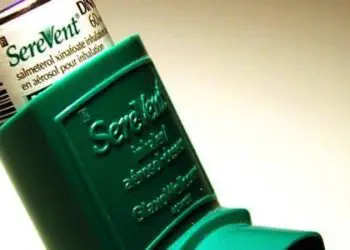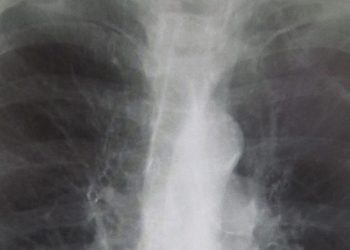No significant benefit of long-acting muscarinic antagonists over long-acting beta-agonists in reducing exacerbation risk in uncontrolled, persistent asthma
1. Adjunct long-acting muscarinic antagonist (LAMA) use with corticosteroids was associated with reduced exacerbation risk compared with placebo in patients with uncontrolled, persistent asthma.
2. LAMA, long-acting beta-agonist (LABA), and inhaled corticosteroids (triple therapy) were not associated with lower risk of exacerbations compared to LABA and inhaled corticosteroids alone.
Evidence Rating Level: 1 (Excellent)
Study Rundown: Management of persistent asthma includes the use of daily inhaled corticosteroids (ICS). As disease severity increases, LABAs are added or the dose of ICS increases, but it is unclear what the role for adjunct LAMAs might be. The current study is a systematic review and meta-analysis that analyzed the utility of adding a LAMA as an adjunct therapy to ICS or to ICS and LABA together in patients with uncontrolled, persistent asthma older than 12 years of age. Overall, the addition of a LAMA versus placebo to ICS significantly reduced the risk of exacerbations requiring systemic corticosteroids. However, adding LAMA to ICS did not offer significant improvements in exacerbation risks compared to adding LABA or doubling the dose of ICS. Finally, using LAMA, LABA, and ICS together (triple therapy) was not associated with significant reduction in exacerbation risk.
Overall, the study suggests that while LAMA does significantly reduce the risk of asthma exacerbations compared to placebo, clinical outcomes are similar when compared to adjunct LABA. The study did not consider the harms or costs associated with one treatment over the other, and these may influence clinical practice and treatment decisions. As LAMA (such as tiotropium) is now approved for use in children as young as 6, future studies may evaluate the clinical benefit of treatment with LAMA in this group.
Click to read the study, published in JAMA
Relevant Reading: A phase III randomized controlled trial of tiotropium add-on therapy in children with severe symptomatic asthma.
In-Depth [systematic review]: The current study is a systematic review and meta-analysis that searched MEDLINE, EMBASE, Cochrane Central Register of Controlled Trials, and Cochrane Database of Systematic Reviews. Included studies evaluated patients 12 years and older with uncontrolled, persistent asthma that compared LAMA vs placebo or vs another add-on therapy to ICS or that compared triple therapy (LAMA, LABA and ICS) to ICS and LABA. Progressive increase in asthma symptoms or a decrease in morning peak expiratory flow (PEF) of 30% or more for 2 or more days was defined as an asthma exacerbation. Data synthesis was based on pharmacologic class (LAMA, LABA, or ICS) as opposed to an individual drug. Overall, 15 randomized clinical trials (N = 7122 patients) were identified. Adjunct LAMA, compared to a placebo, demonstrated significant reduction in asthma exacerbation (RR, 0.67 [95% CI, 0.48 to 0.92]. When compared to adjunct LABA, adjunct LAMA did not offer significant benefits in reducing risk of asthma exacerbation (RR, 0.83 [95% CI, 0.53 to 1.42] or other outcomes of interest. Triple therapy was not associated with significant reduction in asthma exacerbation risk (RR, 0.84 [95% CI, 0.57 to 1.22].
Image: CC/Wiki
©2018 2 Minute Medicine, Inc. All rights reserved. No works may be reproduced without expressed written consent from 2 Minute Medicine, Inc. Inquire about licensing here. No article should be construed as medical advice and is not intended as such by the authors or by 2 Minute Medicine, Inc.






